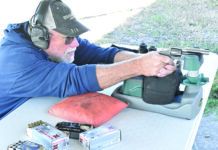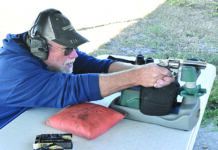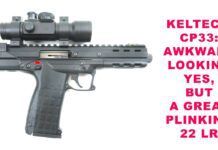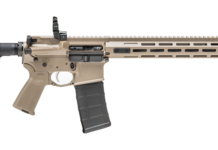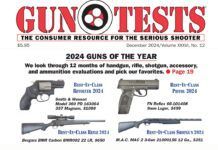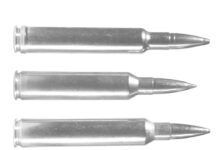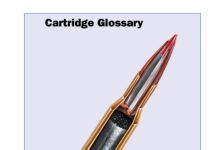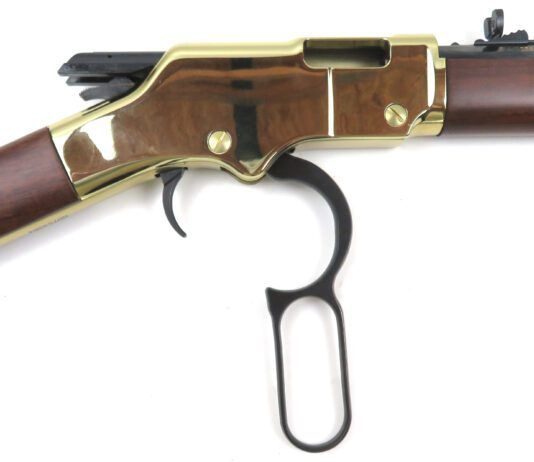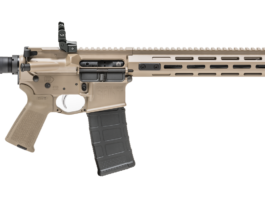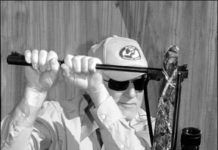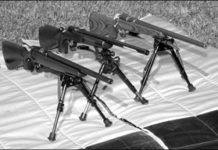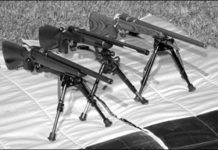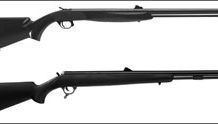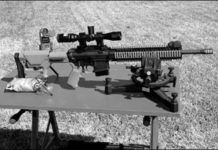First-Ever Airgun Shoot-Off: Gamo, Walther, and Norica
According to a search of our website, gun-tests.com, we have never tested air rifles. Then again, weve never seen the cost of ammunition rise the way it has in the past year. Air rifles are commonly used in competition and as a training device for young shooters, and also for killing small game and pest control where firearms would overpenetrate. So we thought it might be worthwhile to try some air rifles to see if they were an economical vehicle for sharpening our skills. In this test we evaluated four single-shot pump-action air rifles. They were the $319 Gamo Whisper Deluxe No. 611006754, the $325 Walther Falcon Hunter No. 225226, and two Spanish-made rifles by Norica, the $220 Dream Rider and the $290 Marvic Gold.These rifles are new imports available to retailers through Camfour, Incorporated (camfour.com). Both the Walther and the Norica Dream Rider were 22-caliber rifles. Our Norica Marvic Gold fired 25-caliber pellets, and our Gamo rifle shot the popular .177-inch-wide pellet.With little precedence for test procedure we went about making a list of what we would be looking for and how we would judge each product. Reliability is always our first concern. Even a weapon that fires five shots into one hole and then quits running is going to get a failing grade. Next to reliability was ease of operation. Specifically, would working the pump be so tiring that shooting wouldnt be fun anymore? We also wanted to know if the sights on these rifles were reliable and easy to adjust. Would mounting a scope be worthwhile, and how secure was scope placement likely to be atop the smallish rails? Would the triggers prove to be precise or fatiguing? Could these guns actually supply us with valuable practice time?When it came to setting up accuracy tests we had to determine what distance we should shoot them at. Olympic air rifle distance is 10 meters or, about 33 feet. But given the fact that these rifles were shipped with scopes ranging in magnification from 3X to 9X, we concluded that none of our rifles were designed for that distance. We also considered that the lead text for the Whisper Series rifles on the gamousa.com website reads, "This New Models, [sic] will change the way you think about hunting with airguns." In preliminary tests we had fired standing from 36 feet and using only the open sights each of the rifles seemed capable of near perfect accuracy. To determine which rifle or rifles were superior, we would have to fire from a greater distance.Through research we learned that in England organized competitions for air rifles such as those ruled by the UK Association of Rimfire Benchrest Shooting specify targets set at 25 meters. We decided to collect data by firing from a distance of 25 yards with scopes in place utilizing a setup for rifle weve used many times. This meant a Ransom rifle rest beneath the fore end and a Protektor rear bag underneath the stock. In this manner we collected data for our accuracy chart. To satisfy our curiosity about the efficiency of the open sights on each rifle, we removed the scopes and fired a single six-shot group from the bench. From this pattern we calculated an average five shot group size. Would this test prove too severe? Lets pump up the action and see what we learned.
Entreprise-Type FAL, L1A1 308 Win.
Shooters who have considered purchasing a semiautomatic rifle chambered for .308 (7.62 NATO) likely balk at the question of which rifle they should buy, bypassing completely the question of whether to buy such a gun. Unquestionably, self-loading .308s are coveted by nearly everybody, mainly because they can do so much. They can compete, they can plink, they can hunt, and, of course, they’re made for self-defense, should such a situation arise. Though there are many options if you care to search them out, there are basically three readily available rifle types in .308. They are the FAL, the M1A (M14 clone), and the HK-91. The L1A1 FAL, equipped as we’ve described it below, is a very good alternative to the M1A Springfield, and may be less costly.
Brady Campaign State Scorecards: California, NJ Restrict Freedom the Most
WASHINGTON, D.C.–The Brady Campaign has released its annual state scorecards, which the group claims 'rate each state on the strength of its gun laws.'
Colt AR-15 A2 Sporter II .223
Black rifles, mouse guns, great machines, useless junk — these are a few of the names given to our country’s current military rifle and its semi-automatic civilian clones, which are commonly called AR-15 types. Let’s first clear the air by stating they are certainly not useless junk. The design, which some consider fragile, is instead war-proven and more than adequate for its purpose. They don’t have the punch of a .308, but ammo for them is lighter and cheaper. They work, last a long time, are easily maintained, and are in many ways delightful.
Wisconsin Teacher Placed on Leave for Facebook Posting with Rifle
Beaver Dam school officials placed a middle school teacher on administrative leave after discovering a photograph of the teacher with a gun on the teacher's Facebook page.
Rock River Arms LAR-15 223 Rem.
The Rock River was a well-made, shorty version of the AR-15. Some slight feature differences would make the ultimate choice up to you. In both cases, we think the shorty AR-style rifles are better choices than the similar Ruger Mini-14.
Ruger 77 Mark II 243 Heavy Barrel
This was an attractive $685 rifle, with a blonde-colored laminated stock sporting an extremely nice and well-done matte finish. After our initial negative experiences with the electronic Remington, the entirely conventional Ruger, with no gizz-whizzes or batteries or insulators needed to make it go bang, was most welcome. Besides .243, the same rifle is available in .223, .22-250, .220 Swift, 25-06 and .308.
The 26-inch-long stainless-steel barrel was free-floated evenly all the way back to the action. (So was the Remington's.) The Ruger's bolt felt a trifle stiff at first, but after cycling it a few times, it became very slick.
Toss-Up: 22 WMR Bolt Rifles from CZ, Ruger, and Browning
Shortly before the Christmas holiday, members of our staff were contemplating a return to North Dakota for a prairie dog hunt. One of our concerns, however, was the cost of ammunition. The last time we traveled to the Bismarck-Mandan area, (discoverbismarckmandan.com), game was so plentiful we expended a huge amount of ammunition. Our .204 Ruger bolt-action rifles proved to be an excellent choice, but if we were going to make the trip again, we had to find a way to cut costs. We considered a change to rimfire rifles. Our first impulse was to load up on 17 HMR ammunition. But after checking prices and availability, we decided on a more traditional round that was cheaper and easier to find, 22 Winchester Magnum Rifle, or 22 WMR. Its been a long time since we tested varmint rifles chambered for 22 WMR, so we rounded up a representative trio. The three rifles we chose were the $729 Browning T-Bolt Target/Varmint No. 025176204, the $527 CZ 452 Varmint No. 02041, and the $812 Ruger K77/22-VMBZ Target Grey Magnum Varmint Rifle. Each rifle offered at least one substantive feature that distinguished it from the others. Our tests would determine if one gun was superior to the others or simply more suitable for one individual or another. Our ammunition costs ran from $8.99 per 50-round box of Winchester 40-grain JHP from Walmart to $11.95 per 50 rounds of 50-grain Federal Game-Shok hollowpoints purchased at our test site, American Shooting Centers in Houston. The Winchester rounds were tipped with exposed lead, and we think they probably should be listed as semi-jacketed hollow points. We also shot some $9.99 CCI 40-grain Maxi-Mag JHP rounds that we found at Academy Sports and Outdoors. We could have purchased more exotic rounds, but we decided to stay within a price range that was more typical of readily available 22 WMR ammunition.
Toss-Up: 22 WMR Bolt Rifles from CZ, Ruger, and Browning
Shortly before the Christmas holiday, members of our staff were contemplating a return to North Dakota for a prairie dog hunt. One of our concerns, however, was the cost of ammunition. The last time we traveled to the Bismarck-Mandan area, (discoverbismarckmandan.com), game was so plentiful we expended a huge amount of ammunition. Our .204 Ruger bolt-action rifles proved to be an excellent choice, but if we were going to make the trip again, we had to find a way to cut costs. We considered a change to rimfire rifles. Our first impulse was to load up on 17 HMR ammunition. But after checking prices and availability, we decided on a more traditional round that was cheaper and easier to find, 22 Winchester Magnum Rifle, or 22 WMR. Its been a long time since we tested varmint rifles chambered for 22 WMR, so we rounded up a representative trio. The three rifles we chose were the $729 Browning T-Bolt Target/Varmint No. 025176204, the $527 CZ 452 Varmint No. 02041, and the $812 Ruger K77/22-VMBZ Target Grey Magnum Varmint Rifle. Each rifle offered at least one substantive feature that distinguished it from the others. Our tests would determine if one gun was superior to the others or simply more suitable for one individual or another. Our ammunition costs ran from $8.99 per 50-round box of Winchester 40-grain JHP from Walmart to $11.95 per 50 rounds of 50-grain Federal Game-Shok hollowpoints purchased at our test site, American Shooting Centers in Houston. The Winchester rounds were tipped with exposed lead, and we think they probably should be listed as semi-jacketed hollow points. We also shot some $9.99 CCI 40-grain Maxi-Mag JHP rounds that we found at Academy Sports and Outdoors. We could have purchased more exotic rounds, but we decided to stay within a price range that was more typical of readily available 22 WMR ammunition.
Affordable 50-Cal Muzzleloaders: Knight Vs. Thompson/Center
Muzzleloading has enjoyed unprecedented growth over the last 20 years-unprecedented not just compared to its own prior popularity, but also compared to shooting sports in general. As of today, we have an estimated 3.5 to 4.5 million muzzleloading enthusiasts in the United States. Along the way, we have had offering of both good and bad equipment-some additions that have made the sport safer, more enjoyable, practical, and effective, and more than a few attempts that have not. The current story has its roots back in 1985, when railroad man William Anthony 'Tony' Knight named his first muzzleloading rifle the 'MK-85' after his daughter Michelle, and sought to modernize the sport. It took more than a few years, not taking firm root until the mid-1990s, but the pull-cock or 'Enfield type' action Mr. Knight employed proved reliable, and the Knight legacy began. Gary 'Doc' White, M.D., took a close look at the older Sir James Whitworth rifle and made his own Enfield-style rifles revered by many to this day such as his 'Super 91.' It is a good thing to see what you are shooting at, a very good thing indeed, and his modern treatments of ancient inline designs were more easily scoped, making the rifles both safer for everyone and more humane to use for those with less than perfect vision, meaning just about everyone. Thompson/Center, entering the firearms business with the production of Warren Centers Contender, finally decided that its sidelocks were no longer competitive with the Knight and White products, and released its copy of the Knight/White style of rifle as the T/C Black Diamond. From the mid-1990s until 2002, things stayed very much the same. In 2000-2002, though, there were big changes. Master riflesmith Henry Balls patents found life in the superb Savage 10ML and 10ML-II rifles, a Thompson office-bet fling at producing muzzleloading barrels for the T/C Encore found surprising success, serving as impetus for the break-action craze, and in 2002 Thompson-Center surprised the muzzleloading world with its Omega, one of the most successful (and copied) muzzleloaders of the day.
6.8 SPC AR-15 Carbines: The Stag Arms 5L Gets the Nod
The AR-15 platform is booming not only in total unit sales but also in aftermarket accessories such as buttstocks, hand guards, sights, you name it. Perhaps even more significant is the availability of ARs chambered for calibers other than .223 Remington-the greatest indication that shooters like something is that theyre willing to tinker with it.In this test we will evaluate three such carbines with 16-inch barrels chambered for 6.8mm SPC ammunition. All three of these models were flat-top designs featuring a Picatinny rail atop the receiver. They were the $1114 DPMS AP4 Panther Carbine that came with a $124 JP Enterprises trigger upgrade; the $925 RRA LAR-6.8 Mid-Length A4 from Rock River Arms, and a left hand (left-side ejection) 5L from Stag Arms. The base price of a Stag Arms 5L was $1095, but our Stag was customized with several options that added nearly $1000 to the retail list price.Would these features give the Stag an unfair advantage when compared to the Rock River and DPMS products? We think the answer is no, and here is why. Given the modular design of the basic platform, every feature found on the customized Stag 5L could also be applied to our other test samples as well as any other AR, carbine or rifle. Therefore, we felt that we would be able to isolate the benefit of a given modification and render judgment on the basic weapon. For example, if the compensator on the Stag were to help us get better hits, we still might prefer one of the other carbines but recommend the application of said compensator.The 6.8 SPC presents a bullet that is about 0.27 inches in diameter typically weighing 110 to 115 grains. The difference in overall cartridge size between 6.8 SPC and .223 Remington ammunition does not appear to be major. But 6.8 SPC magazines of the same length as 30-round .223 magazines hold five rounds fewer. Our test ammunition was Remingtons 115-grain Express Rifle OTM and two rounds from Hornady Manufacturing. They were the 110-grain V-Max Varmint Express and 115-grain BTHP/WC Custom loads.Our first encounter with a 6.8 SPC carbine was reported in the November 2008 issue of Gun Tests. This was Rugers handy Mini 14. Now we had a chance to see if this caliber was better suited to the AR-15. We began our tests by mounting a Nikon Monarch 2-8X32mm BDC scope No. 8438. This was a 1-inch-tube scope with four circles below the crosshairs for instant holdover. We liked the Monarchs range of power and its clear field of vision. We could have chosen this same model with the Nikoplex reticle instead of the BDC circles for $10 less, (catalog number 8437), but we were curious to see if the reticle really worked. We mounted the scope utilizing a Yankee Hill Machine scope riser and a pair of B-Square Tactical Tri-rings ($74 from brownells.com). We think the addition of Nikon target turrets enhanced function as well as visual appeal. For collecting accuracy data from the 100-yard line we traveled west from downtown Houston to American Shooting Centers located in George Bush Park (amshootcenters.com). Our first step was to zero each carbine at the 50-yard bench. We blended in a break-in regimen of cleaning the barrel every five shots for the first 25 rounds. A fouling shot was fired after each cleaning. Then we moved to the 100-yard line to readjust our point of impact and record the width of five-shot groups, measuring the holes widest apart from center to center. We also planned a 200-yard firing session utilizing the first holdover circle and a rapid-fire test. Here is what we learned.
Fulton Armory Peerless NM M14 Rifle .308
To the basic rifle price ($2,500) must be added the prices for the gorgeous McMillan M3A stock ($600), the ARMS steel scope mount ($150), extended rail ($100), bipod ($70), swivel package ($100), and a leather sling ($50). There was also a Krieger barrel ($200). The total package, less scope but with mount and rings, came to $3,770. With the Leupold scope, the tag would be about $4,620 as tested. We got our prices out of the maker’s catalog and may have missed a few things, so it’s best to contact Fulton for an exact quote on your needs. We had the loan of some scopes with state-of-art add-ons set up specifically for the M14 that bear close scrutiny.Fulton’s Peerless rifle was easily the most impressive-looking of this test trio. When we pulled it out of its box, we were struck by its purposeful beauty. Everything about the rifle was flat black except for the exposed Krieger stainless barrel, which was in the white, with a decent but not glaring polish. The McMillan M3A stock felt just great. Its pistol grip was acutely angled to give near-perfect trigger control.


